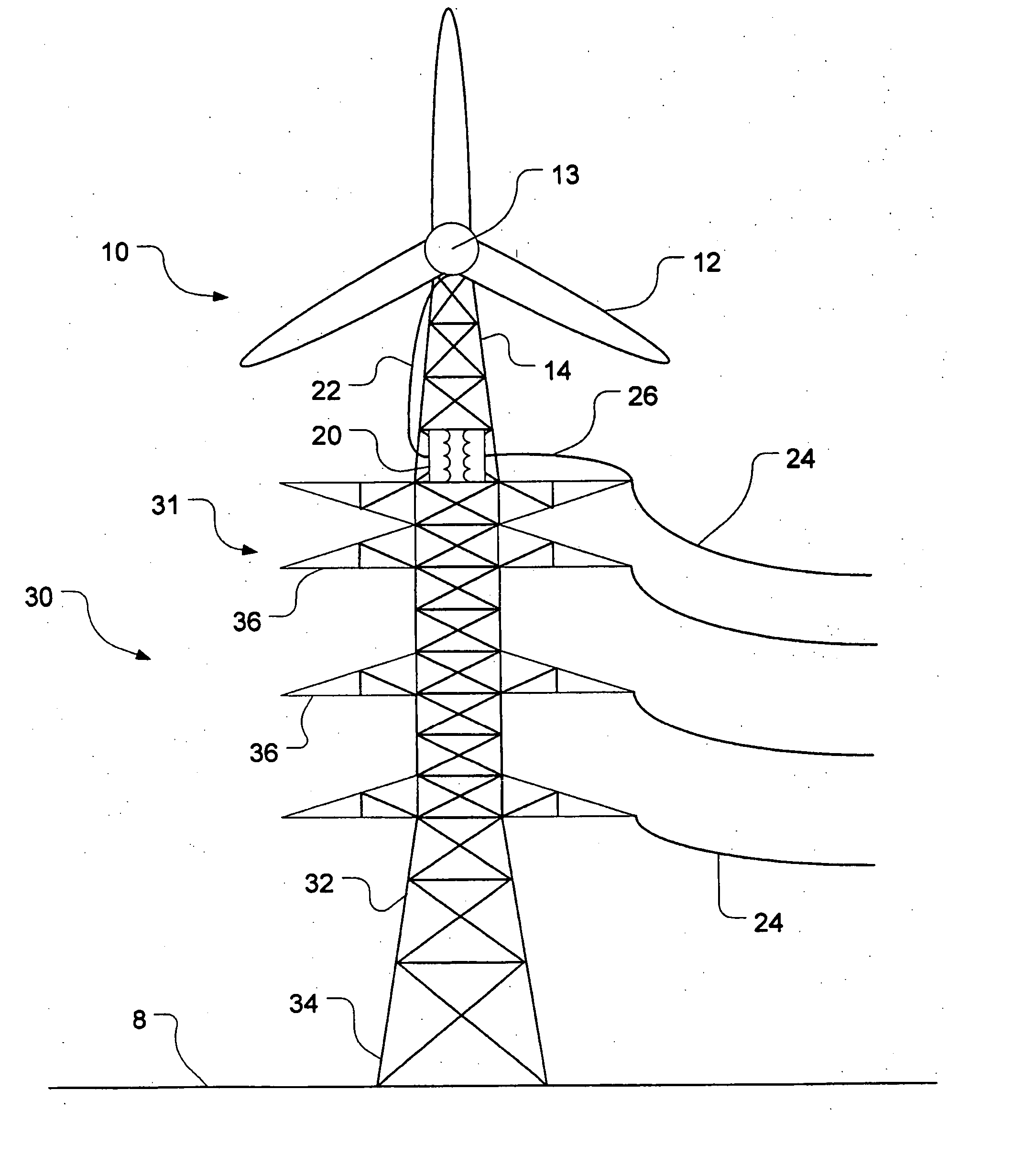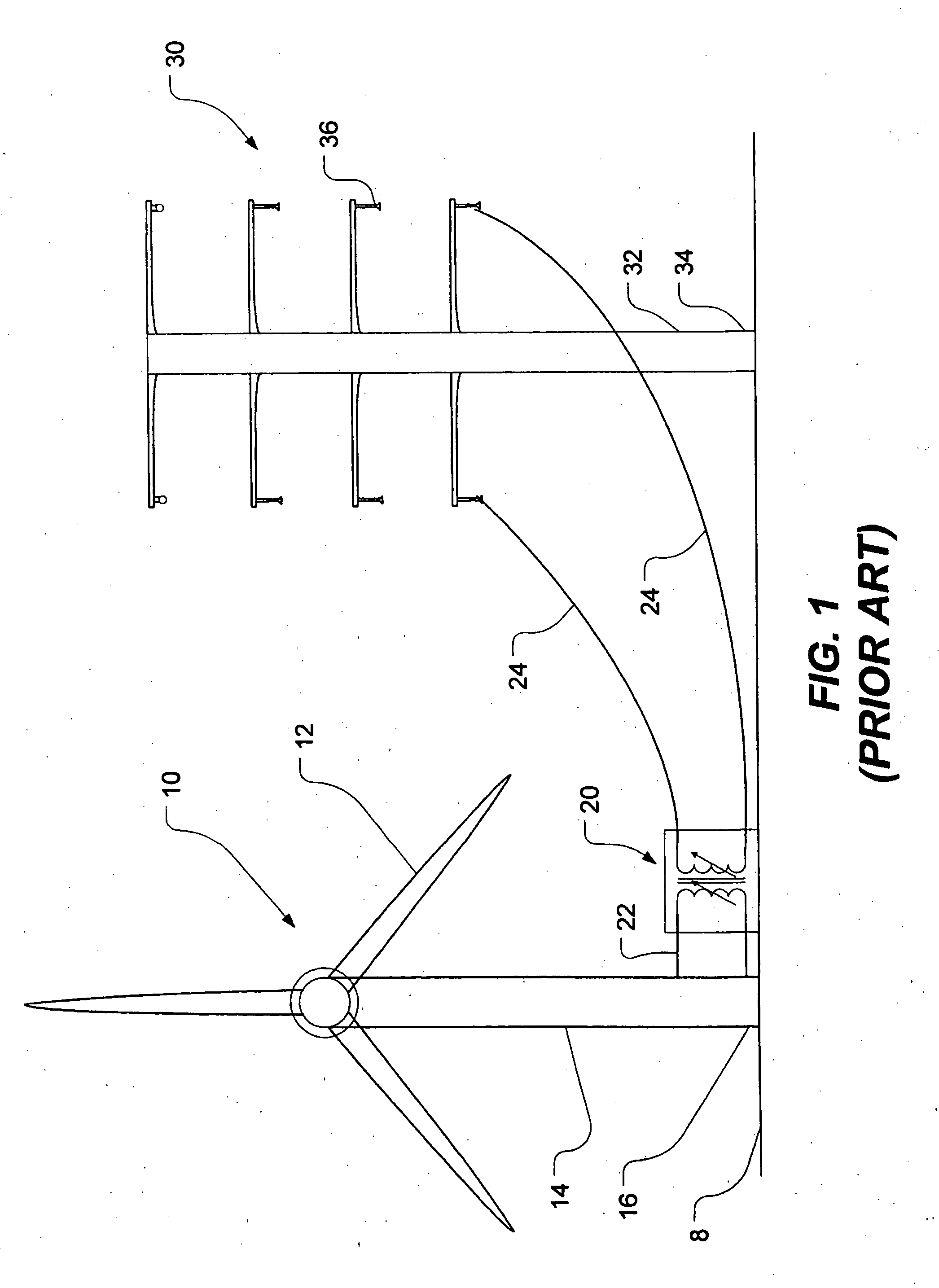Wind turbine mounted on power transmission tower
a technology of wind turbines and power transmission towers, applied in wind energy generation, motors, sustainable buildings, etc., can solve the problems of reducing the overall cost-effectiveness of wind power generation, occupying large tracts of land, and reducing the cost of purchasing or leasing land, so as to reduce the cost of building, reduce the visual and aesthetic impact on the environment, and reduce the cost of line losses.
- Summary
- Abstract
- Description
- Claims
- Application Information
AI Technical Summary
Benefits of technology
Problems solved by technology
Method used
Image
Examples
first embodiment
[0026]FIG. 2 shows a horizontal-axis wind turbine generally designated by reference numeral 10 mounted to a power transmission tower 30 in accordance with the present invention. For the purposes of this specification, the expression “power transmission tower” includes any transmission tower, distribution tower, tower, pole or other structure capable of carrying electric power lines above ground.
[0027] As shown in FIG. 2, the horizontal-axis wind turbine 10 has three rotor blades 12 for driving an electric generator, which is housed within a nacelle 13. The generator is preferably horizontal-axis as well although its orientation may conceivably differ depending on the connection between the rotor and the generator. For the purposes of this specification, the expression “generator” means a generator, alternator or any other electricity-producing device capable of converting the kinetic energy of a rotor into electricity.
[0028] of course, the wind turbine may have a different number o...
second embodiment
[0031]FIG. 3 shows the present invention in which a horizontal-axis wind turbine 10 is mounted atop a monopole power transmission tower 30. The tower structure 32 of the monopole tower is typically tapered. The base 34 of the tower is anchored to the ground 8. The tower has a plurality of supporting arms 36 for suspending power lines. Connected to the top of the tower 30 is the wind turbine 10. The wind turbine is supported above the power lines by a substructure or tower extension 14 which, in this case is monopole although it could be lattice or hybrid. The transformer 20 is mounted either to the wind turbine or to the power transmission tower 30. Electric lines feed power that is generated by the wind turbine into the power lines 24. The wind turbine is shown to be a horizontal-axis wind turbine. This horizontal-axis wind turbine may be mounted anywhere on the power transmission tower provided it does not interfere with the power lines. However, the horizontal-axis wind turbine i...
third embodiment
[0032]FIG. 4 depicts the present invention in which a wind turbine 10 is mounted atop a power transmission tower 30 having a hybrid tower structure 32. Such towers are known as “hybrid” because they are a combination of lattice and monopole structures. In this case, the hybrid tower has three support legs, as shown. Mounted atop the hybrid power transmission tower 30 is a lattice substructure or tower extension 14 which supports a wind turbine 10. The substructure 14 could also be monopole or hybrid. The wind turbine 10 has a horizontal-axis generator housed within the nacelle 13. A transformer 20, mounted either to the tower extension 14 or to the power transmission tower 30, steps up the voltage being output from the wind turbine before being fed into the power lines carried by the supporting arms 36 of the power transmission tower 30.
PUM
 Login to View More
Login to View More Abstract
Description
Claims
Application Information
 Login to View More
Login to View More - R&D
- Intellectual Property
- Life Sciences
- Materials
- Tech Scout
- Unparalleled Data Quality
- Higher Quality Content
- 60% Fewer Hallucinations
Browse by: Latest US Patents, China's latest patents, Technical Efficacy Thesaurus, Application Domain, Technology Topic, Popular Technical Reports.
© 2025 PatSnap. All rights reserved.Legal|Privacy policy|Modern Slavery Act Transparency Statement|Sitemap|About US| Contact US: help@patsnap.com



